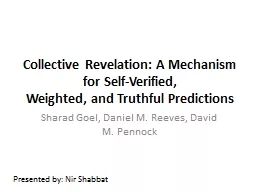PPT-Collective Revelation: A Mechanism for Self-Verified,
Author : cheryl-pisano | Published Date : 2016-07-31
Weighted and Truthful Predictions Sharad Goel Daniel M Reeves David M Pennock Presented by Nir Shabbat Outline Introduction Background and Related Work The
Presentation Embed Code
Download Presentation
Download Presentation The PPT/PDF document "Collective Revelation: A Mechanism for S..." is the property of its rightful owner. Permission is granted to download and print the materials on this website for personal, non-commercial use only, and to display it on your personal computer provided you do not modify the materials and that you retain all copyright notices contained in the materials. By downloading content from our website, you accept the terms of this agreement.
Collective Revelation: A Mechanism for Self-Verified,: Transcript
Download Rules Of Document
"Collective Revelation: A Mechanism for Self-Verified,"The content belongs to its owner. You may download and print it for personal use, without modification, and keep all copyright notices. By downloading, you agree to these terms.
Related Documents














